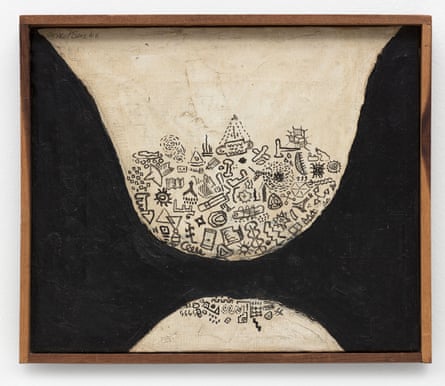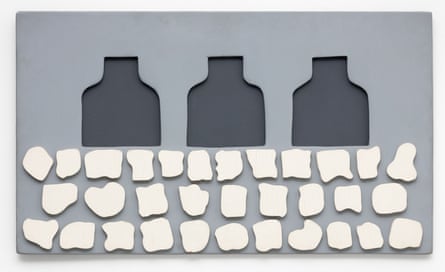How varied and strange the paintings of Forrest Bess are. Wonky black tables stumbling in a room. Rows of identical mustachioed faces and rows of dicks and something like a snowflake made of string. A face in a golden flower, if it is a flower, in front of a mesa under a red sky. Sometimes they are ungraspable. The kinds of optical disturbances you get when you press your knuckles against your closed eyelids. Creatures in a field: are they dogs? Cattle? Sheep? Arching over them is either the plugged head of a penis, a bicycle seat or something else entirely.

Things get stranger still in Out of the Blue, the first institutional show of the late American artist’s work in the UK. Born in 1911 south of Bay City, Bess worked for a spell in his youth as an oilfield roughneck, briefly studied architecture and, following a false-start period of awkward expressive figuration and still lifes, was attached to a camouflage unit during the second world war before suffering a breakdown. Beginning in the 1940s, Bess began recording the visions that came to him before sleeping. He said that he drew and then painted them as accurately as he could. The more you look, the more their apparent simplicity and directness reveals an intricate mind.
Washed in artificial light, the small paintings glow against black walls (Bess always wanted to hang his paintings on black walls, but this is the first occasion when they have been.) Hung roughly chronologically, Bess’s paintings are stories told in the dark; many, with their very basic unpainted wood frames (the timber salvaged wherever he found it) were also meant to be held, to be examined and deciphered. The painter understood that they were objects as much as images, and messages from the unconscious as much as abstractions. His paintings kept changing but, somehow, always stayed the same.
Bess seemed to be as much their transcriber as author, and the paintings themselves appear fully worked-out, with few revisions or evident changes of mind in their construction. They appear direct and emphatic, yet often frustratingly unreadable. His surroundings at Chinquapin Bayou are in them – reflections of moonlight on water, the sun and moon. Earning a meagre living trawling prawns and catching and selling bait-fish to sport fishermen, Bess lived for much of his life on a small island on the edge of a community just off the Texas coast in a treeless landscape of tidal flats and low islands, sand-bars and bayous. He painted in a succession of ramshackle dwellings that he frequently had to rebuild following hurricanes and storms. Things seen and experienced here undoubtedly got into his paintings, but they are also filled with forms and symbols that are difficult to decode, even though he also drew annotated crib-sheets that gave a sense of what these symbols referred to.

Bess was never quite a loner or an outsider, and showed with the Betty Parsons’ Gallery in New York from 1950 until 1967, where his stable-mates included Jackson Pollock, Mark Rothko, Barnett Newman and, later, Ellsworth Kelly and Agnes Martin. However, Bess felt treated like a hick in New York and retreated south. His sense of self-discovery did not depend on the city. Bess was also an inveterate letter-writer, and kept up a correspondence with the distinguished art historian Meyer Schapiro (an early champion); other correspondents included Carl Jung and Bruno Bettelheim, as well as Parsons herself. He also wrote to President Dwight Eisenhower.
Although sometimes regarded as self-taught, he was both well-connected and intellectually curious. He studied alchemy, Taoism and sexuality. Bess also wanted to become a hermaphrodite and made at least two attempts at self-surgery in the 1950s. Bess wrote a thesis expounding his ideas, illustrated with medieval woodcuts, medical illustrations and photographs of his own genitalia. The thesis has now been lost, although fragments of illustrated letters on the theme are included in the Camden show, as well as pages from his letters, gallery catalogues and other material (the vitrines are too high for small children to come across the more alarming images included here).

Many artists have felt driven by ideas and beliefs that we might find opaque, naive or wearying, yet without them, the work of Hilma af Klint, Kandinsky and Mondrian would not have developed as it did. Theosophy, arcane colour symbolism, faith systems and even belief in alien visitations have all had their place in some artists’ work, alongside more mainstream religious and philosophical beliefs, however well or poorly digested. How well did Pollock know his Jungian archetypes, or Barnett Newman his Kabbalah? Does it matter? A rich inner life is not to be scoffed at if it gets you through the day.
There is a deep purposefulness and precision in some of Bess’s most enigmatic works. In one painting, two regular pink rectangles sit on a dark ground. Bleeding away from one rectangle, an uneven area of raw, broken red slews over the edge of the canvas. The sculptor Robert Gober (who has thought a lot about Bess) has described these rectangles as testicles. In other paintings we can read visionary landscapes, shafts into the body, dualities and splittings, orifices and golden sperm coursing through the testes, and heaps of symbols jostling in the brain. Bess died in 1977 and his work remains both implacable and ungraspable. It haunts me still.
This article was amended on 4 October 2022. A previous version said that Forrest Bess served in the first world war, rather than the second.
Forrest Bess: Out of the Blue is at Camden Art Centre, London, until 15 January.
